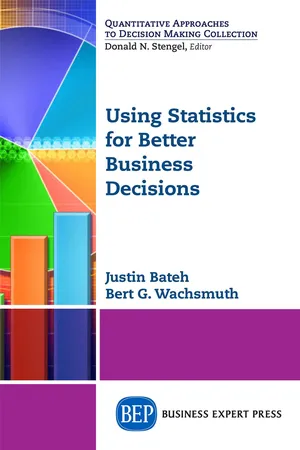
- 260 pages
- English
- ePUB (mobile friendly)
- Available on iOS & Android
Using Statistics for Better Business Decisions
About this book
More and more organizations around the globe are expecting that professionals will make data-driven decisions. Employees, team leaders, managers, and executives that can think quantitatively should be in high demand. The goal of this book is to increase ability to identify a problem, collect data, organize, and analyze data that will help aid in making more effective decisions. This book will provide you with a solid foundation for thinking quantitatively within your company. To help facilitate this objective, this book follows two fictitious companies that encounter a series of business problems, while demonstrating how managers would use the concepts in the book to solve these problems and determine the next course of action. This book is for beginners and does not require prior statistical training. All computations will be completed using Microsoft Excel.
Frequently asked questions
- Essential is ideal for learners and professionals who enjoy exploring a wide range of subjects. Access the Essential Library with 800,000+ trusted titles and best-sellers across business, personal growth, and the humanities. Includes unlimited reading time and Standard Read Aloud voice.
- Complete: Perfect for advanced learners and researchers needing full, unrestricted access. Unlock 1.4M+ books across hundreds of subjects, including academic and specialized titles. The Complete Plan also includes advanced features like Premium Read Aloud and Research Assistant.
Please note we cannot support devices running on iOS 13 and Android 7 or earlier. Learn more about using the app.
Information
- Set up Microsoft Excel to run statistical analyses
- Understand the importance of random sampling
- Demonstrate how to use Microsoft Excel to identify a random sample
- Understand basic vocabulary in the statistics field
- Explain the importance in using statistics for business decision making
- Identify the sources and types of data used in business.
- Corporate presidents decide company policy based on quarterly sales figures.
- Politicians decide on campaign strategy base...
Table of contents
- Cover
- Title
- Copyright
- Abstract
- Contents
- Chapter 1: Statistics and Statistical Software
- Chapter 2: Data Visualization
- Chapter 3: Numerical Data Summary
- Chapter 4: Probability Theory
- Chapter 5: Estimation
- Chapter 6: Hypothesis Testing
- Chapter 7: Association Between Categorical Variables
- Chapter 8: Linear Regression
- Chapter: 9 Analysis of Variance
- Index
- Adpage
- Backcover